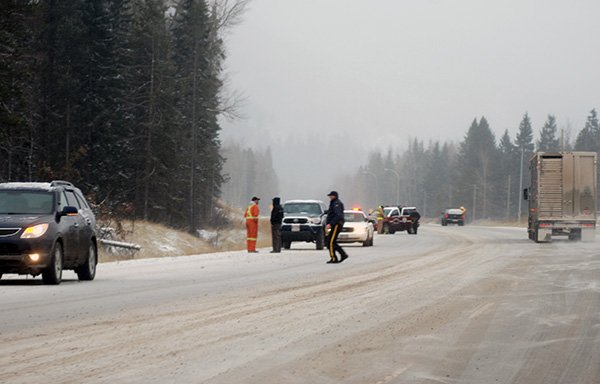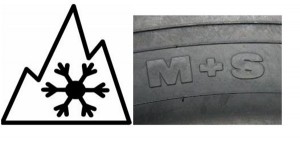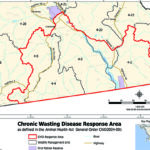Home »

Be prepared; tips about winter tires
Drivers in British Columbia are only a third of the way through the winter driving season. Depending on where you live or work in the province, travel on winter roads and highways can be challenging.
It’s not too late to ‘shift into winter’ and winterize your vehicle, starting with winter tires. Winter tires outperform other types of tires in all winter conditions once the temperature drops below seven degrees Celsius. Winter tires maintain their elasticity even at extremely low temperatures providing superior traction and grip, improving your ability to stop on snow and ice.
Between October 1 and March 31, most B.C. Highways require passenger vehicles to be equipped with mountain/snowflake or mud and snow tires, and commercial vehicle drivers are required to carry chains.
Tires with the mountain/snowflake symbol offer the best traction on snow and ice, and in cold weather.
 Tires with the M+S (Mud and Snow) symbol offer better traction than summer tires but are less effective than mountain/snowflake tires on snow and ice, and in cold weather.
Tires with the M+S (Mud and Snow) symbol offer better traction than summer tires but are less effective than mountain/snowflake tires on snow and ice, and in cold weather.
In all cases, a winter tire must be in good condition, with a minimum 3.5 mm tread depth.
“We want everyone to be safe while driving our highways in winter. Safety starts at the bottom, with good winter tires with a minimum tread depth of 3.5 mm. Proper tires, and being prepared for weather conditions, are necessary precautions for safe journeys,” said Minister of Transportation and Infrastructure Todd Stone
“With winter fast approaching, now is the time to think about how to make winter driving as safe as possible. No matter where in the province you live or work, shifting into winter means employers and workers need to make sure their vehicles are ready for ice, snow and mud by getting the right winter tires and checking their vehicle’s condition. This winter, let’s ensure everyone gets home safely,” stated Shirley Bond, Minister of Jobs, Tourism and Skills Training and Minister Responsible for Labour.
“While winter tires and vehicle condition are important from a safety perspective, a driver’s decision concerning when to drive in the winter, and their safe driving behaviour when operating a vehicle, are the most important considerations in keeping them, their family and other road users safe,” added WorkSafeBC Industry and Labour Services Manager Mark Ordeman.
The Winter Tires and Chains page on the Government of BC website provides an overview of the types of winter tires required for use on signed BC highways during the winter driving season.
Many drivers use their personal vehicles for work purposes. Employers should make sure their employees make it through the winter driving season safely, regardless of the vehicle being driven.
The new Employer Tool Kit on the Shift Into Winter website is a free, step-by-step guide to help businesses of any size keep their workers safe while driving in winter. The tool kit contains user-friendly information resources to help you prepare workers and vehicles for winter, keep them safe on the roads during the winter months, and assess the past season while planning for the next.
Employers looking for specific information can also download individual checklists, tip sheets and other educational materials that can be presented at crew talks or monthly health and safety meetings.
No matter where in the province you live or work, on average the number of crashes resulting in injury or fatality in B.C. due to driving too fast for the conditions spikes significantly between October and December. The average number of incidents over a five-year period from 2009 to 2013, rose from 121 crashes in October to 234 crashes in December. (Source: ICBC Annual Average Casualty Crashes due to Driving too Fast for conditions –2009-2013 Police Reported Data)
Shift Into Winter is an annual road safety initiative of the Winter Driving Safety Alliance that helps build awareness about winter weather-related driving hazards, and educates drivers about safer driving practices and behaviours, whether they drive for leisure or work.
About the Winter Driving Safety Alliance
The Winter Driving Safety Alliance is a joint provincial initiative comprised of organizations committed to improving the safety of drivers during the winter months. They are the B.C. Road Builders and Heavy Construction Association, Ministry of Transportation and Infrastructure, WorkSafeBC, Justice Institute of British Columbia, Automotive Retailers Association, B.C. Forest Safety Council, B.C. Trucking Association, Insurance Corporation of B.C., Kal Tire, Pacific Coach Lines, the City of Prince George, RCMP, and the Trucking Safety Council of B.C.
About WorkSafeBC
WorkSafeBC is an independent provincial statutory agency governed by a board of directors that serves about 2.2 million workers and more than 215,000 employers. WorkSafeBC was born from the historic compromise between B.C.’s workers and employers in 1917 where workers gave up the right to sue their employers and fellow workers for injuries on the job in return for a no-fault insurance program fully paid for by employers. WorkSafeBC is committed to safe and healthy workplaces and to providing return-to-work rehabilitation and legislated compensation benefits.
Submitted







